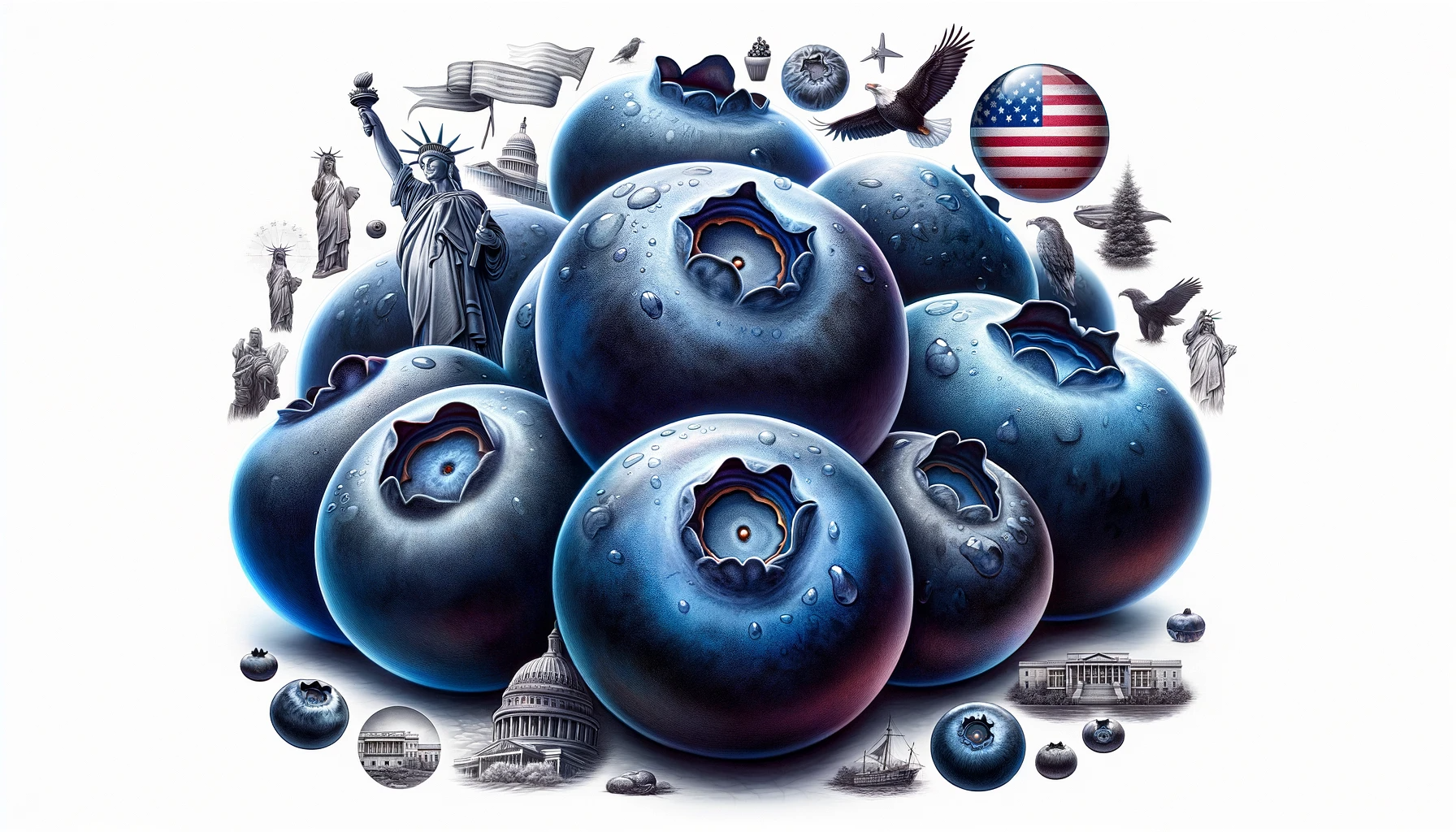
The concept of a national fruit, such as the blueberry being the National Fruit of the USA, is rooted in the symbolic representation of a nation's identity, cultural heritage, and natural resources.
National symbols, including fruits, are chosen for their deep connection to a country's history, landscape, and cultural practices. The blueberry, a small yet significant berry, exemplifies this perfectly for the United States.
Its selection as the national fruit reflects not just the country's botanical diversity but also its cultural tapestry.
Blueberries have a unique history in the USA, deeply intertwined with the indigenous practices and the nation's agricultural development.
The National Fruit Of The USA
The National Fruit of the USA is the blueberry, a small, vibrant berry known for its deep blue to purple-black colour and slightly waxy surface. Blueberries are typically 5-16 millimetres in diameter, offering a delightful burst of flavour that's a harmonious blend of sweet and tart.
This fruit stands out for its nutritional value, packed with antioxidants, vitamin C, and dietary fibre. A unique aspect of blueberries is their growth habit – they grow on perennial shrubby bushes, not trees, varying in size from a modest 10 centimetres to as tall as 4 meters.
Their appearance and taste vary slightly between the common highbush and lowbush varieties. This versatile fruit is significant in American cuisine and culture, symbolizing the rich and diverse American landscape.
The blueberry's small size belies its substantial impact in terms of nutritional benefits and its status as a national symbol, reflecting the broader characteristics of the United States itself.
Historical Context Of The USA's National Fruit
The historical context of the blueberry, the USA's national fruit, is deeply rooted in the country's heritage and agricultural history. Blueberries originated in North America and have been a significant part of the American diet for centuries.
Native Americans were the first to recognize the fruit's value, using it extensively for nutritional and medicinal purposes. They even taught early European settlers about their cultivation and use.
The journey of blueberries from wild bushes to cultivated crops is a relatively recent phenomenon, dating back to the early 20th century.
This shift began with pioneering work by USDA botanist Frank Coville and New Jersey farmer Elizabeth White in the 1910s. Their collaboration led to the discovery that blueberries require acidic soil for growth.
This breakthrough paved the way for widespread cultivation. The blueberry gained national prominence in the 1990s and early 2000s when research identified its numerous health benefits, branding it as a "superfood."
Cultural Significance Of The USA's National Fruit
The blueberry, as the USA's national fruit, holds a special place in American culture, symbolizing the nation's agricultural richness and cultural diversity. Its cultural significance is reflected in various facets of American life, from literature and art to national celebrations.
In literature, blueberries have been celebrated in children's books such as "Blueberries for Sal" by Robert McCloskey, which captures the simplicity and joy of blueberry picking. This and other literary works echo the fruit's integration into the fabric of American childhood and family life.
In art and folklore, blueberries are often depicted as quintessentially American, symbolizing the rustic and bountiful American countryside.
They are celebrated in numerous local festivals, particularly in states like Maine, where blueberry festivals showcase the fruit in myriad forms, from jams to pies, highlighting its central role in American culinary traditions.
Nutritional Profile And Health Benefits
As the National Fruit of the USA, the blueberry boasts an impressive nutritional profile, rich in vitamins, minerals, and plant compounds, contributing to its various health benefits.
A 3.5-ounce (100-gram) serving of blueberries contains only 57 calories, making them a low-calorie yet nutrient-dense food. They are particularly high in vitamin C and K1, and manganese and provide moderate amounts of dietary fibre.
Vitamin C, a potent blueberry antioxidant, is crucial for skin health and immune function. Vitamin K1, or phylloquinone, is vital in blood clotting and bone health.
Manganese plays an essential role in protein and carbohydrate metabolism, while fibre supports digestion and sustains prolonged satiety. Renowned for abundant antioxidants, blueberries, particularly anthocyanins, contribute to their distinct blue hue.
The connection between these antioxidants and a diminished risk of heart disease is evident, as they potentially impede the oxidation of LDL (bad) cholesterol.
The National Fruit In American Cuisine
The blueberry, the National Fruit of the USA, is a versatile and beloved ingredient in American cuisine, featured in a myriad of dishes that range from traditional to innovative. Its culinary uses reflect the nation's creative and diverse food culture.
A classic representation is the blueberry muffin, an iconic breakfast item in American households and diners.
These muffins celebrate the fruit's delightful flavour and are a staple in American baking. Similarly, blueberry pancakes, often drizzled with maple syrup, are a favourite, especially when studded with fresh or frozen berries.
Blueberries also star in one of America's quintessential desserts - the blueberry pie. Blueberry pie symbolizes American tradition and festivity, particularly during the Fourth of July celebrations.
Comparison With Other National Fruits
Comparing the blueberry, the National Fruit of the USA, with the national fruits of other countries reveals interesting similarities and differences in symbolism, cultural significance, and usage.
For instance, India's national fruit, the mango, like the blueberry, is deeply rooted in the country's culture and history. While the blueberry symbolizes American resilience and heritage, the mango in India is a symbol of prosperity, love, and fertility.
Both fruits are integral to their respective national cuisines but differ in usage; blueberries are commonly used in desserts and baked goods, whereas mangoes are prevalent in various dishes, from sweets to savoury.
Similarly, Japan's national fruit, the persimmon, contrasts with the blueberry in taste and texture yet shares a deep cultural significance. While blueberries are celebrated for their health benefits and versatility in various dishes, persimmons in Japan symbolize good luck and success and are often used in traditional ceremonies.
In terms of symbolism, the apple, recognized unofficially as a national fruit in many countries, shares the blueberry's representation of health and vitality. However, the apple symbolizes knowledge and temptation in Western culture, differing from the blueberry's representation of natural abundance and American heritage.
FAQs
What Is The National Fruit Of The USA?
The National Fruit of the USA is the blueberry.
Why Were Blueberries Chosen As The USA's National Fruit?
Blueberries symbolize American cultural heritage, resilience, and the rich diversity of the land. They also have a unique history intertwined with indigenous practices and American agriculture.
What Are The Health Benefits Of Blueberries?
Overflowing with antioxidants, blueberries boast abundant vitamins C and K1 and a generous dose of manganese. They benefit heart health, brain function, and blood sugar control.
How Do Blueberries Feature In American Cuisine?
In American cuisine, blueberries are used in muffins, pancakes, pies, smoothies, and savoury dishes, reflecting their versatility.
How Do Blueberries Compare To Other National Fruits?
While similar in their cultural significance to fruits like India's mango and Japan's persimmon, blueberries differ in their symbolism and culinary uses, representing American heritage and versatility.
Can Blueberries Be Grown In Home Gardens?
Blueberries can be grown in home gardens, provided they have acidic soil, adequate sunlight, and proper care, including regular watering and pruning.
Final Words
The blueberry's status as the National Fruit of the USA is a testament to its deep-rooted connection with American history, culture, and agriculture. Originating as a cherished resource for Native Americans, it has evolved into a symbol of resilience and natural abundance. Blueberries are a tasty and nutritious fruit and a representation of the diverse American landscape. Their cultural significance is evident in literature, art, and culinary traditions, making them an integral part of American life.
